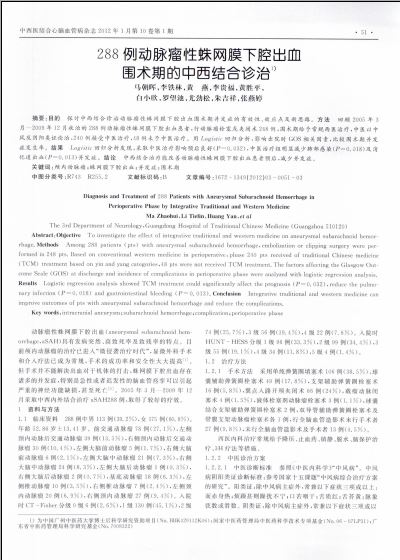288例动脉瘤性蛛网膜下腔出血围术期的中西结合诊治(1)
 |
| 第1页 |
参见附件。
摘要:目的 探讨中西结合诊治动脉瘤性蛛网膜下腔出血围术期并发症的有效性、效应点及新思路。方法 回顾2005年3月—2009年12月收治的288例动脉瘤性蛛网膜下腔出血患者,行动脉瘤栓塞或夹闭术248例,围术期给予常规西医治疗,中医以中风及阴阳类证论治,240例接受中医治疗,48例未予中医治疗。用Logistic回归分析,影响出院时GOS相关因素,比较围术期并发症发生率。结果 Logistic回归分析发现,采取中医治疗影响预后良好(P=0.032),中医治疗组明显减少肺部感染(P=0.018)及消化道出血(P=0.013)并发症。结论 中西结合治疗能改善动脉瘤性蛛网膜下腔出血患者预后,减少并发症。
关键词:颅内动脉瘤;蛛网膜下腔出血;并发症;围术期
中图分类号:R743 R255.2 文献标识码:B 文章编号:1672-1349(2012)01-0051-03
Diagnosis and Treatment of 288 Patients with Aneurysmal Subarachnoid Hemorrhage in Perioperative Phase by Integrative Traditional and Western Medicine
Ma Zhaohui,Li Tielin,Huang Yan,et alThe 3rd Department of Neurology,Guangdong Hospital of Traditional Chinese Medicine (Guangzhou 510120)
Abstract:Objective To investigate the effect of integrative traditional and western medicine on aneurysmal subarachnoid hemorrhage.Methods Among 288 patients (pts) with aneurysmal subarachnoid hemorrhage,embolization or clipping surgery were performed in 248 pts.Based on conventional western medicine in perioperative,phase 240 pts received of traditional Chinese medicine(TCM) treatment based on yin and yang categories,48 pts were not received TCM treatment.The factors affecting the Glasgow Outcome Scale (GOS) at discharge and incidence of complications in perioperative phase were analyzed with logistic regression analysis.Results Logistic regression analysis showed TCM treatment could significantly affect the prognosis (P=0.032),reduce the pulmonary infection (P=0.018) and gastrointestinal bleeding (P=0.013).Conclusion Integrative traditional and western medicine can improve outcomes of pts with aneurysmal subarachnoid hemorrhage and reduce the complications.
Key words:intracranial aneurysm;subarachnoid hemorrhage;complication;perioperative phase
动脉瘤性蛛网膜下腔出血(aneurysmal subarachnoid hemorrhage,aSAH)具有发病突然、高致死率及致残率的特点。目前颅内动脉瘤的治疗已进入“微侵袭治疗时代”,显微外科手术和介入疗法已成为常规,手术的成功率和安全性大大提高[1]。但手术并不能解决出血对于机体的打击,蛛网膜下腔出血存在诸多的并发症,特别是急性或者迟发性的脑血管痉挛可以引起严重的神经功能缺损,甚至死亡[2]。2005年3月—2009年12月采取中西内外结合治疗aSAH288例,取得了较好的疗效。
1 资料与方法
1.1 临床资料 288例中男113例(39.2%),女175例(60.8%)。年龄52.86岁±13.41岁。前交通动脉瘤78例(27.1%),左侧颈内动脉后交通动脉瘤39例(13.5%),右侧颈内动脉后交通动脉瘤30例(10.4%),左侧大脑前动脉瘤5例(1.7%),右侧大脑前动脉瘤6例(2.1%),左侧大脑中动脉瘤21例(7.3%),右侧大脑中动脉瘤24例(8.3%),左侧大脑后动脉瘤1例(0.3%),右侧大脑后动脉瘤2例(0.7%),基底动脉瘤18例(6.3%),左侧椎动脉瘤10例(3.5%),右侧椎动脉瘤7例(2.4%),左侧颈内动脉瘤20例(6.9%),右侧颈内动脉瘤27例(9.4%)。 入院时CT-Fisher分级0级6例(2.6%),1级130例(45.1%),2级74例(25.7%),3级56例(19.4%),4级22例(7.6%)。 入院时HUNT-HESS分级1级96例(33.3%),2级99例(34.4%),3级55例(19 ......
您现在查看是摘要介绍页,详见PDF附件(1635kb)。